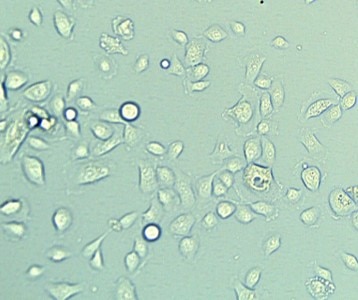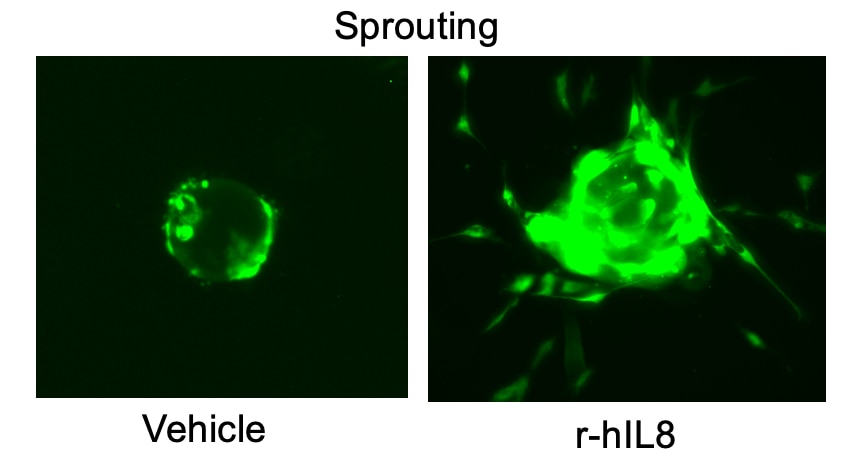Recombinant Human IL-8/CXCL8 (Endothelial Cell Derived) Summary
Product Specifications
Ala23-Ser99 & Ser28-Ser99
Analysis
Customers also Viewed
Product Datasheets
Carrier Free
CF stands for Carrier Free (CF). We typically add Bovine Serum Albumin (BSA) as a carrier protein to our recombinant proteins. Adding a carrier protein enhances protein stability, increases shelf-life, and allows the recombinant protein to be stored at a more dilute concentration. The carrier free version does not contain BSA.
In general, we advise purchasing the recombinant protein with BSA for use in cell or tissue culture, or as an ELISA standard. In contrast, the carrier free protein is recommended for applications, in which the presence of BSA could interfere.
618-IL
| Formulation | Lyophilized from a 0.2 μm filtered solution in PBS with BSA as a carrier protein. |
| Reconstitution | Reconstitute at 100 μg/mL in sterile PBS containing at least 0.1% human or bovine serum albumin. |
| Shipping | The product is shipped at ambient temperature. Upon receipt, store it immediately at the temperature recommended below. |
| Stability & Storage: | Use a manual defrost freezer and avoid repeated freeze-thaw cycles.
|
618-IL/CF
| Formulation | Lyophilized from a 0.2 μm filtered solution in PBS. |
| Reconstitution | Reconstitute at 100 μg/mL in sterile PBS. |
| Shipping | The product is shipped at ambient temperature. Upon receipt, store it immediately at the temperature recommended below. |
| Stability & Storage: | Use a manual defrost freezer and avoid repeated freeze-thaw cycles.
|
Background: IL-8/CXCL8
Interleukin-8 (IL-8), also known as CXCL8, GCP-1, and NAP-1, is a widely expressed proinflammatory member of the CXC family of chemokines. Near its N-terminus, this 8-9 kDa chemokine contains an ELR motif which is important for its angiogenic properties (1). CXCL8 can associate into a homodimer or a heterodimer with CXCL4/PF4 (2), and it can also interact with matrix and cell surface glycosaminoglycans (3). Mature human CXCL8 shares 65%-69% amino acid (aa) sequence identiity with canine, feline, and porcine CXCL8 (4). There is no CXCL8 gene counterpart in rodent. N-terminal truncation by multiple proteases generates a range of shorter forms, and an alternative splice form of human CXCL8 carries an eleven aa substitution at the C-terminus (5). The bioactivity of CXCL8 is regulated by these truncations, by CXCL8 citrullination at Arg5 (N-terminal to the ELR motif) (6), and by the decoy receptor DARC (7). CXCL8 effects are mediated through CXCR1/IL-8 RA, which is also used by CXCL6, and through CXCR2/IL-8 RB, which is used by multiple CXC chemokines (1). CXCR1 and CXCR2 associate into functional homodimers and heterodimers with each other (8). Through both CXCR1 and CXCR2, CXCL8 promotes neutrophil adhesion to the vascular endothelium and migration to sites of inflammation (9). It triggers the antimicrobial activation of neutrophils through CXCR1 (10). CXCL8 also binds to Serpin A1/alpha-1 Antitrypsin, and this prevents CXCL8 interaction with CXCR1 (11). CXCL8 is upregulated in atherosclerotic lesions and other cardiac pathologies where it exacerbates inflammatory tissue damage (12). In addition, it induces VEGF expression, vascular endothelial cell proliferation, angiogenesis, and tumor cell invasiveness (13-16).
- Lazennec, G. and A. Richmond (2010) Trends Mol. Med. 16:133.
- Nesmelova, I.V. et al. (2005) J. Biol. Chem. 280:4948.
- Pichert, A. et al. (2012) Biomatter 2:142.
- Schmid, J. and C. Weissmann (1987) J. Immunol. 139:250.
- Mortier, A. et al. (2008) Pharmacol. Ther. 120:197.
- Proost, P. et al. (2008) J. Exp. Med. 205:2085.
- Neote, K. et al. (1994) Blood 84:44.
- Munoz, L.M. et al. (2009) J. Immunol. 183:7337.
- Gerszten, R.E. et al. (1999) Nature 398:718.
- Jones, S.A. et al. (1996) Proc. Natl. Acad. Sci. USA 93:6682.
- Bergin, D.A. et al. (2010) J. Clin. Invest. 120:4236.
- Apostolakis, S. et al. (2009) Cardiovasc. Res. 84:353.
- Martin, D. et al. (2009) J. Biol. Chem. 284:6038.
- Li, A. et al. (2005) Angiogenesis 8:63.
- Waugh, D.J. and C. Wilson (2008) Clin. Cancer Res. 14:6735.
- Fernando, R.I. et al. (2011) Cancer Res. 71:5296.
Citations for Recombinant Human IL-8/CXCL8 (Endothelial Cell Derived)
R&D Systems personnel manually curate a database that contains references using R&D Systems products. The data collected includes not only links to publications in PubMed, but also provides information about sample types, species, and experimental conditions.
5
Citations: Showing 1 - 5
Filter your results:
Filter by:
-
Widespread potential for growth-factor-driven resistance to anticancer kinase inhibitors.
Authors: Wilson TR, Fridlyand J, Yan Y, Penuel E, Burton L, Chan E, Peng J, Lin E, Wang Y, Sosman J, Ribas A, Li J, Moffat J, Sutherlin DP, Koeppen H, Merchant M, Neve R, Settleman J
Nature, 2012-07-26;487(7408):505-9.
Species: Human
Sample Types: Whole Cells
Applications: Bioassay -
Tumor-derived chemokine MCP-1/CCL2 is sufficient for mediating tumor tropism of adoptively transferred T cells.
Authors: Brown CE, Vishwanath RP, Aguilar B, Starr R, Najbauer J, Aboody KS, Jensen MC
J. Immunol., 2007-09-01;179(5):3332-41.
Species: Human
Sample Types: Whole Cells
Applications: Bioassay -
Leukemia inhibitory factor functions as a growth factor in pancreas carcinoma cells: Involvement of regulation of LIF and its receptor expression.
Authors: Kamohara H, Ogawa M, Ishiko T, Sakamoto K, Baba H
Int. J. Oncol., 2007-04-01;30(4):977-83.
Species: Human
Sample Types: Whole Cells
Applications: Bioassay -
Chondrocyte hypertrophy and apoptosis induced by GROalpha require three-dimensional interaction with the extracellular matrix and a co-receptor role of chondroitin sulfate and are associated with the mitochondrial splicing variant of cathepsin B.
Authors: Olivotto E, Vitellozzi R, Fernandez P, Falcieri E, Battistelli M, Burattini S, Flamigni F, Santi S, Borzi RM
J. Cell. Physiol., 2007-02-01;210(2):417-27.
Species: Human
Sample Types: Whole Cells
Applications: Bioassay -
Murine CXCR1 is a functional receptor for GCP-2/CXCL6 and interleukin-8/CXCL8.
Authors: Fan X, Patera AC, Pong-Kennedy A, Deno G, Gonsiorek W, Manfra DJ, Vassileva G, Zeng M, Jackson C, Sullivan L, Sharif-Rodriguez W, Opdenakker G, Van Damme J, Hedrick JA, Lundell D, Lira SA, Hipkin RW
J. Biol. Chem., 2006-12-29;282(16):11658-66.
Species: Mouse
Sample Types: Complex Sample Type
Applications: Binding Assay
FAQs
-
Are mouse or rat CXCL8/IL-8 products offered?
Mouse and rat do not have a gene which encodes CXCL8/IL-8. In mouse, the functional homologs to human CXCL8/IL-8 are CXCL1/KC and CXCL2/MIP-2. In rat, the functional homolog to CXCL8/human IL-8 is CXCL3/CINC-2.
-
What is the difference between 208-IL (rhCXCL8/IL-8) and 618-IL (rhEndothelial Cell-Derived IL-8/CXCL8)?
Several N-terminal processed forms of CXCL8/IL-8 are produced by proteolytic cleavage after secretion by cells such as peripheral blood monocytes, leukcocytes and endothelial cells. Catalog # 208-IL consists only of the sequence Ser28 to Ser99 (also known as IL-8, 6-77), which is the most prominent form of IL-8. According to literature, IL-8(6-77) has a 5-10-fold higher activity in neutrophil activation. Catalog # 618-IL consists of Ser28 to Ser99 (IL-8, 6-77) and Ala23 to Ser99 (IL-8). In our chemoattraction assay, 208-IL has a 2-fold higher activity than 618-IL.Several N-terminal processed forms of CXCL8/IL-8 are produced by proteolytic cleavage after secretion by cells such as peripheral blood monocytes, leukcocytes and endothelial cells. Catalog # 208-IL consists only of the sequence Ser28 to Ser99 (also known as IL-8, 6-77), which is the most prominent form of IL-8. According to literature, IL-8(6-77) has a 5-10-fold higher activity in neutrophil activation. Catalog # 618-IL consists of Ser28 to Ser99 (IL-8, 6-77) and Ala23 to Ser99 (IL-8). In our chemoattraction assay, 208-IL has a 2-fold higher activity than 618-IL.
Reviews for Recombinant Human IL-8/CXCL8 (Endothelial Cell Derived)
Average Rating: 5 (Based on 2 Reviews)
Have you used Recombinant Human IL-8/CXCL8 (Endothelial Cell Derived)?
Submit a review and receive an Amazon gift card.
$25/€18/£15/$25CAN/¥75 Yuan/¥2500 Yen for a review with an image
$10/€7/£6/$10 CAD/¥70 Yuan/¥1110 Yen for a review without an image
Filter by:



















